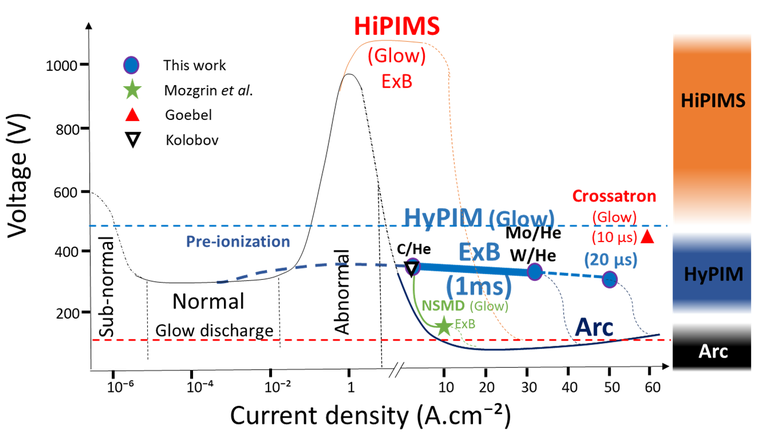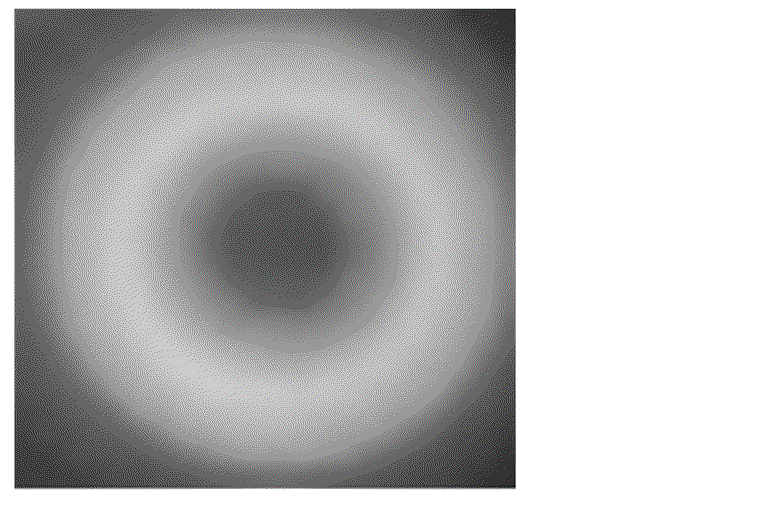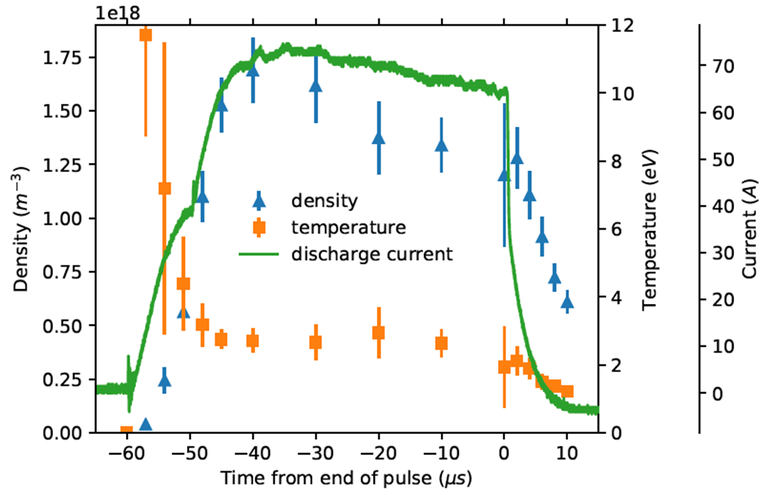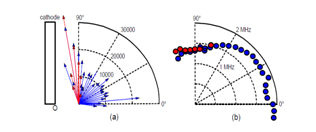Experimental characterisation of magnetron plasma
contact : Tiberiu Minea
Although magnetron plasma is widely used as a technological tool for surface coatings, the physics governing these high-density, low-pressure plasmas is only partially understood. The difficulties are inherent in all so-called E x B plasmas, which are produced in crossed electric and magnetic field structures.
This discharge has been the subject of fundamental research ever since it was discovered over 50 years ago. The positive ions in the plasma are accelerated towards the cathode (or target), causing the atoms that make it up to sputter. These atoms then pass through the plasma and are deposited on the anode (or substrate), creating a deposit. The special feature of the magnetron is the low working pressure made possible by the addition of a magnetic field that effectively traps the electrons, thereby increasing the rate of ionisation of the gas (usually Argon). The advent of new ways of transmitting electrical power to the plasma, in particular through the application of High Power Impulse Magnetron Sputtering (HiPIMS), has opened up new horizons and potential for these plasmas. HiPIMS plasma considerably broadens the range of phenomena to be explored by adding a time dimension that separates the gas ionisation, sputtering and sputtered material ionisation phases. As a result, the properties of the films obtained are improved [1].
For many years, the LPGP has been working to understand the various mechanisms at work in the magnetron, both in the plasma and in the transport of the sputtered material. One of the main difficulties lies in the inaccessibility of experimental measurements as close as possible to the cathode, where the electric and magnetic fields are the strongest. However, the latest advances in Thomson scattering have provided some answers about the instability present in this region, electron drift and its impact on the behaviour of the discharge.
1) New operating mode for E x B plasmas
The studies carried out at LPGP on High Power Impulse Magnetron Sputtering (HiPIMS) have accompanied the development of these discharges since their introduction in the 2000s. The HiPIMS magnetron has now become a versatile tool that can be used not only to improve the quality of deposited films, but also to better control growth conditions and, in some cases, to obtain near-perfect atomic arrangements, such as epitaxial growth [2].
Following a discharge physics approach, we find the HiPIMS regime to be an extension of the abnormal glow discharge regime, both towards high voltages and towards high currents. Indeed, for a voltage typically 2 to 3 times higher than conventional magnetron discharge operation, the current in HiPIMS mode is 100 to 1000 times higher, but with a duty cycle of 100 to 1000, so that the average current density on the cathode (target) is equivalent. However, this extension remains relatively small, because by trying to increase the operating voltage and above all the current density (> 10 A cm-2), the HiPIMS discharge inevitably evolves into an electric arc. This transition is easily identified by a sudden drop in voltage, simultaneous with an increase in current [3].
An open question in discharge physics to date is how a plasma can operate in luminescent mode, but with current densities exceeding 10 A cm-2.
We have found the conditions for such operation, perfectly distinct from the abnormal regime, but also from the well-known electric arc. This regime is characterised by very high currents, typical of electric arcs. (up to 50 A cm-2), while maintaining operation in luminescent mode (‘glow’), i.e. no formation of cathode spots, no ejection of particles, and above all no drop in voltage below 100V.
This new mode has been named Hyper Power Impulse Magnetron [4] (HyPIM glow discharge). In fact, by reducing the voltage by 2/3 compared with HiPIMS, the discharge current in the same magnetron-type E x B configuration increases by a factor of 6 compared with the commonly recorded HiPIMS mode. Clearly, these operating points are in the typical arc region, as shown in the figure below (blue dots).

Figure 1 - Les points bleu montre le fonctionnement des décharges luminescentes en configuration E x B dans la région historiquement correspondant aux arcs électriques [4].
This mode of operation was verified with three target materials (carbon (C), molybdenum (Mo) and tungsten (W)) in a 10-30 Pa helium atmosphere. Two critical conditions were identified as necessary to achieve the HyPIM mode:
- the discharge voltage must be limited
- a low pre-ionisation current is essential before the pulse is applied.

Figure 2 - Glow discharge in HyPIM mode, with a current density of 30 A cm-2.
2) Diagnosis of magnetron plasmas and instabilities
Diagnosis of magnetron and pulse-mode plasmas requires both temporal (< 1 µs) and spatial resolution imposed by the strong field gradients (electric and magnetic) that govern the transport and ionisation of species in a region located in front of the cathode, known as the ionisation zone.
Advanced diagnostic techniques using lasers and spectroscopy meet these requirements. Solid-state laser diodes have a line sharpness such that it is possible to discern the spectral profile of the lines probed. Thus, for energetic particles, such as those released by the target during spraying, it is easy to measure the density and their velocity obtained from Doppler broadening, and therefore to measure the fluxes of these species. Depending on the wavelength, these laser absorption or laser-induced fluorescence techniques can provide information on the behaviour of the plasma gas, excited states (particularly metastable), ions, sputtered neutrals, or target material ions formed after passing through the ionisation zone. The accuracy of these measurements has made it possible to evaluate the effective cross-sections of metal-gas interactions (e.g. Titanium - Argon) in a magnetron [5].
Thomson scattering - measurement of electron density and drift as well as plasma instabilities HiPIMS
Precise knowledge of the local electron density in magnetic traps is very important for understanding the behaviour of confined plasmas such as magnetron plasma. The only non-intrusive diagnostic seems to be Thomson scattering, which has been used successfully to measure the electron density and temperature in the magnetic trap of E x B plasmas [6]. Moreover, this technique is sufficiently time-resolved to follow the evolution of the electronic parameters in HiPIMS discharges. It can also be used to measure the speed and direction of electron drift in different discharge regimes, shedding new light on magnetised plasmas.

Figure 3 -Electronic density (blue) and temperature (orange) measured at different times during the 60 µs pulse duration. The HiPIMS current profile is plotted.
In addition, Thomson scattering, this time coherent, made it possible to identify behaviour similar to that modelled by PIC-MCC using the Pseudo-3D approach [7]. A frequency peak is obtained by Fourier transform of the signal - measured or calculated for the electron density - in the MHz range (the plasma pulsation is in the GHz range). These fluctuations are oriented in a direction normal to the cathode (see Figure 4). The modelling shows electron sprays in the normal direction, contributing to plasma deconfinement. Another direction, almost parallel to the cathode, shows a large amplitude of electronic fluctuations, corresponding to electron drift. [8]

Figure 4. Thomson collective scattering results (a) amplitude and (b) frequency as a function of angular orientation in the (E, E x B) plane. O represents the centre of the cathode. DC : Ucath = 370 V, I = 0.4 A; the wave number k = 5600 rad/m.5
[1] Daniel Lundin, Tiberiu Minea, Jon Tomas Gudmundsson, Editors – High Power Impulse Magnetron Sputtering: Fundamentals, Technologies, Challenges and Applications - 1st Edition, ISBN: 9780128124543, Elsevier, 2019
[2] F. Cemin, G. Abadias, T. Minea, D. Lundin, Tuning HiPIMS discharge and substrate bias conditions to reduce the intrinsic stress of TiN thin films, Thin Solid Films 688 (2019) 137335
[3] E. Morel, Y. Rozier, Ch. Ballages, R. Bazinette, T. Forchard, C. Creusot, A. Girodet, T. Minea, Behavior of high current density pulsed magnetron discharge with carbon target, Plasma Sources Sci. Technol. 30 (2021) 125001
[4] E. Morel, T. Minea, Y. Rozier, Hyper Power Impulse Magnetron - HyPIM -glow discharge, Euro. Phys. Lett. (EPL) 138 (2022) 24001
[5] A. Revel, T. Minea, C. Costin,. 2D PIC-MCC simulations of magnetron plasma in HiPIMS regime with external circuit, 2018, PSST, 27, 105009.
[6] S. Tsikata, B. Vincent, C. Ballage, A. Revel, and T. Minea, Time-resolved electron properties of a HiPIMS argon discharge via incoherent Thomson scattering, 2019 Plasma Sources Sci. &Technol. 28(3) (2019) 03LT02
[5] M. Rudolph, A. Revel, D. Lundin, H. Hajihoseini, N. Brenning, M. Raadu, A. Anders, T. Minea, JT Gudmundsson, On the electron energy distribution function in the high power impulse magnetron sputtering discharge, 2021 Plasma Sources Sci. Technol. 30, 045011
[6] A. Revel et. al.Transition from ballistic to thermalized transport of metal-sputtered species in a DC magnetron, 2021, PSST, 30, 125005.
[7] A. Revel, T. Minea, and S. Tsikata Pseudo-3D PIC modeling of drift-induced spatial inhomogeneities in planar magnetron plasmas 2016 Phys. Plasmas 23, 100701
[8] S. Tsikata and T. Minea, Modulated Electron Cyclotron Drift Instability in a High-Power Pulsed Magnetron Discharge, 2015 Phys. Rev. Lett. 114, 185001
